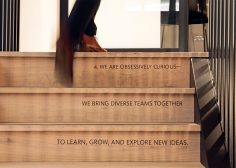
In design businesses, it’s common for leaders to be the face of the business, to nurture existing and future clients, as well as be the key initiators of design. But it’s often also the case that leaders have a challenging time separating themselves from the day to day activities of the business allowing for time and energy to focus on building the business, improving the operations, surrounding themselves with great people and nurturing the future leaders.
It?s often the case that leaders have a challenging time separating themselves from the day to day activities of the business.
This approach often results in profitability taking a back seat to producing brilliant design, which is great for the clients, but not so great for the design practice.
As a leader of a design business you are confronted by a set of circumstances (challenges) that are somewhat unique:
- Often the leader is the face of the business,
- Leaders are typically the key initiator of design and client relationships,
- Leaders have a difficult time separating themselves from the day to day activity of the business,
- Leaders don’t often share financials,
- Effective business management is considered secondary to other considerations including design capability, client relationships and delivering projects,
- Profit and profitability can take a back seat to producing a great design,
- The entrepreneurial drive of the founders is often not found in the second generation, and
- Client relationships tend to be deeper, stronger, and more personalised.
How important are sound business principles in your business? How do you demonstrate and drive this? Do you have a culture of empowerment? It?s incumbent on business leaders to lead by example and set the tone.
Not only that, entrepreneurial vision and drive are often not inherent in the next tier of management, so enthusiasm for your vision, clear strategic objectives that filter through to every aspect of the business, and empowering your people are key to driving your business forward.
How important are sound business principles in your business? How do you demonstrate and drive this? Do you have a culture of empowerment?
What are the priorities for your business and how do you communicate these to your team? Do you pursue a culture of trust, sharing, collaboration, empowerment, performance, and profit? Talk about what you believe in, be open, and address those values in the everyday conversations that you?re having with your people. Use phrases that are inclusive of the collective whole of your business, using the tone and language that reinforces ‘this is important to us’.
Successful leaders, more times than not, exhibit the following personal qualities:
- Have a clear purpose,
- Keep to clear and actionable goals and priorities,
- Are relationship builders,
- Understand and challenge their people,
- Understand the true value of their time,
- Constantly ask themselves ‘am I the right person to be doing this?’,
- Focus on what will make a difference,
- Accept and embrace performance criteria,
- Are realistic (self-assessment),
- Follow up and create energy,
- Effectively balance life and work,
- Let go of design decisions and client relationships,
- Mentor others, and
- Actively pursue professional development.
In most design businesses there are critical elements of the business that the leaders need to drive and ensure they contribute to continuously the business drivers. In a design business, these are typically to generate work, to nurture client relationships and to design and deliver great work. But what about all the areas of the business?
For a design business to be truly successful, the leaders? attention is needed across strategy, communications, design, delivery, innovation, operations, human resources, and financial control. Having said that, most architecture, engineering, and design (AED) leaders that are elevated to senior roles or directors? positions don?t have the necessary business management expertise to manage, direct and drive a successful business that performs across these key business drivers.
For a design business to be truly successful, the leaders? attention is needed across strategy, communications, design, delivery, innovation, operations, human resources, and financial control.
As a leader, you need to be clear about your expectations around client outcomes, project performance, an understanding of financials, and managing deliverables.
None of this comes overnight and it typically requires small steps. It comes through a well-constructed plan, time and experience, and the assistance of your team the team of experts you surround yourself with. It goes without saying that what’s required is a balance between the time you spend ‘in the business’ and ‘on the business’. You need the time out from project-related activities to make this happen.
It goes without saying that what’s required is a balance between the time you spend ‘in the business’ and ‘on the business’.
Be clear about where the business is heading and be prepared to engage your key people in why, where and how you will get there. Ideally, you will be able to empower your staff, hand over control and give some of the responsibility and accountability for achieving your business objectives to others.
Your objective as a leader should be to empower your key people to take on responsibility for project and design delivery, project performance, client relationships, and business systems. Set them up to succeed and flow responsibility for decision making through the business.
Ask yourself the following questions of your key people (and future leaders):
- Are they trained?
- Do they have the necessary skills?
- How much responsibility and accountability do they have?
- Are they responsible for performance (project deliverables)?
- Do they have the information and tools they need?
- Are they financially literate?
- Do they embrace technology?
- Do they delegate well?
And if they don’t have the necessary (or desired) capability, work with them to develop a plan to make it happen. Motivate your team by driving a culture of leadership and ownership succession. Articulate and provide an opportunity for future leaders and be clear about what it takes to become a leader in your practice. By providing a transparent path to leadership you will set the standard for future growth.
Motivate your team by driving a culture of leadership and ownership succession.
Here are some steps to create a culture of leadership among your key people:
- Involve your people in articulating/clarifying your business ‘drivers’ and desired business outcomes e.g. strategy, rainmaking, design, innovation project delivery etc.,
- Define, articulate and measure the performance criteria across these business ‘drivers’,
- Ensure your key people are working in their core capability (set them up to succeed),
- Understand and nurture their inherent personal strengths/weaknesses, temperament, and abilities,
- Include measurable criteria in your executive agreements,
- Provide individual (and team) contribution requirements and link these to the profit/bonus pool, and
- Provide regular (and expert) feedback on performance on a quarterly or 6 monthly basis.
Your business can be the vehicle that enables you to shape and control your destiny ? both in life and your career. Your challenge as a design leader is to balance the creative and commercial aspects of what you do. Successful and effective leaders today more often than not are doing less and achieving more. To borrow from Mies Van Der Rohe ‘less is more’.















